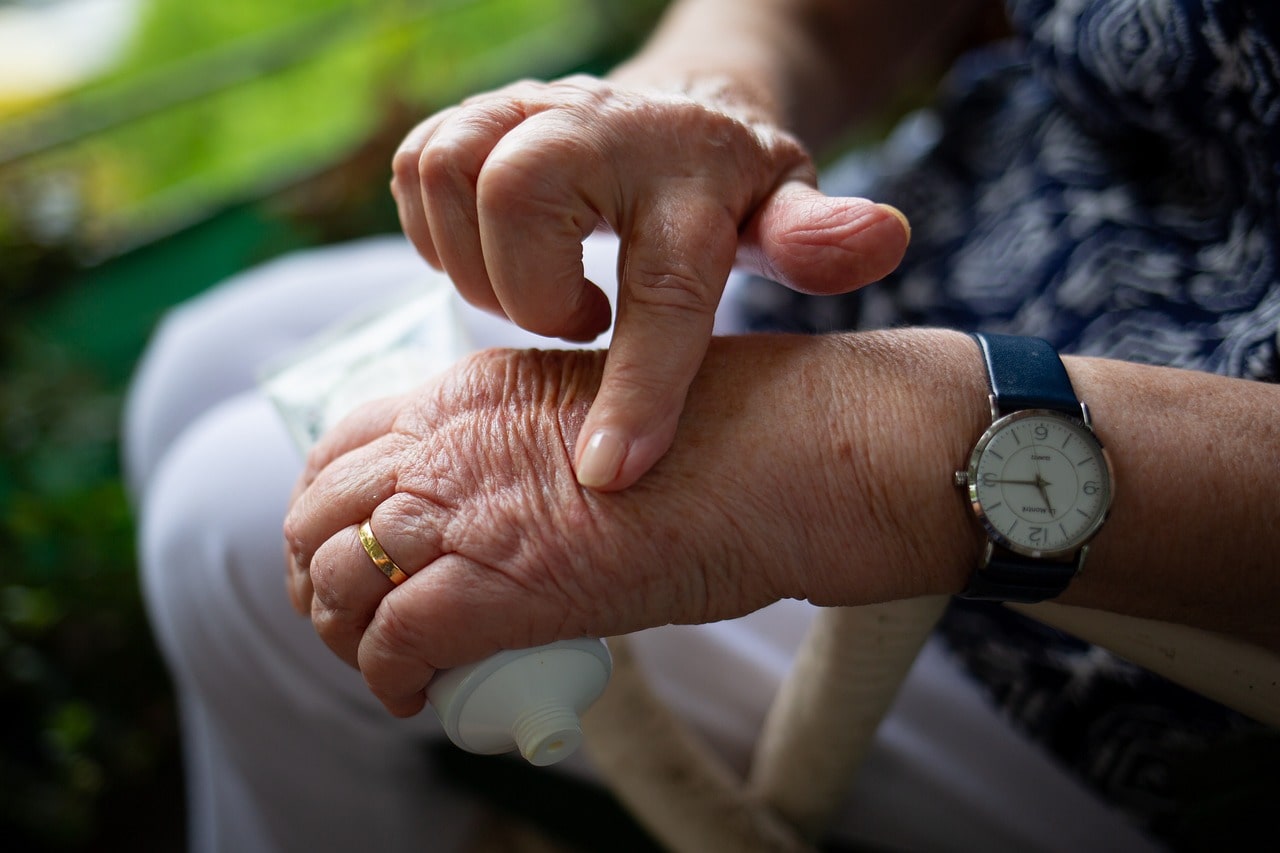Asset Publisher
Living Well with Arthritis
01/15/2020

An older adult putting arthritis cream on their hands
People have been suffering from the pain and stiffness of arthritis for centuries. The earliest signs of the disease were discovered in the skeletons of Native Americans as early as 4500 BC, and in Egyptian mummies dating back 2590 BC.
According to the Arthritis Foundation, about 54 million adults have been diagnosed with arthritis. The first signs of arthritis usually begin around age 40 and progress slowly. Women over 50 are more likely to suffer from arthritis symptoms than men. Even dogs, cats and other animals can suffer from the pain of arthritis.
Although there is no cure for this disease, there are a variety of techniques and remedies we can use to manage a loved one’s pain and help them maintain an active lifestyle.
ARTHRITIS SYMPTOMS
There are many different kinds of arthritis. Osteoarthritis is the most common form. It develops over time as cartilage—the tissue cushion at the ends of bones—wears away, causing pain, swelling and loss of joint mobility. Arthritis symptoms include:
- Pain in the hands, hips, knees, neck and lower back joints
- Joint stiffness, especially in the morning
- Inflamed and tender joints
- Creaking, grating or popping joints
- Deformed and thickened joints
- Limited ability to move a joint
ARTHRITIS RISK FACTORS
According to the Centers for Disease Control and Prevention, about half of people over 65 suffer from arthritis, so chances are high that a loved one we care for may also experience a stiff or aching hand, knee, hip, lower back or neck at some point in their lives. The most commonly affected joints are the shoulder, neck, elbow, wrist, ankle and foot.
- Risk factors for osteoarthritis include:
- Family history
- Obesity
- Previous joint injury or overuse of a joint
- Lack of physical activity
- Growing older
MANAGING ARTHRITIS PAIN
Although arthritis can’t be cured, there are a variety of home remedies and lifestyle changes that can help a loved one feel better. Pain relievers, whether over-the-counter or prescription, can be helpful in managing arthritis pain. However, many of these medications can cause stomach or intestinal upsets and other side effects. We should ask a loved one’s doctor to recommend a safe and effective pain reliever for them.
Other at-home arthritis pain management techniques recommended by the Arthritis Foundation include:
- Weight loss. Losing just 15 pounds can reduce knee pain in overweight older people.
- Wearing sturdy, supportive shoes and using a cane can relieve pain in hips, knees and ankles. Regular, moderate physical activities such as taking a walk can keep joints flexible and improve muscle strength.
- Using heat or ice packs can relieve pain and reduce swelling.
- Soaking in a warm bath.
Physical therapy is also an option for a loved one suffering from arthritis. Physical therapists are experts in helping people of all ages adjust to living with joint-related illnesses like arthritis. A physical therapist can teach a loved one how to reduce strain on arthritic joints and suggest exercise routines to decrease stiffness and increase mobility. Physical therapists may also be able to suggest assistive devices and arthritis aids that will help a loved one manage personal care and household activities safely.
ARTHRITIS AIDS TO MAKE LIFE EASIER
An extensive variety of clever devices are available to help make daily activities easier for older adults with or without physical disabilities. They include such arthritis-friendly gadgets as:
- Grab bars for bathrooms and showers
- Foot warmers
- Kitchen tools and gadgets
- Garden tools
- Canes
- Pens and pencils designed for comfortable writing
- Elbow and knee supports
- Elevated toilet seats
- Long-handled bathroom sponges
Catalogs of such products are available online. Doctors or a local library may be able to help us find information about these and other useful devices.
CAREGIVERS AND ARTHRITIS
Many older adults believe that arthritis pain is just another discomfort of the aging process that they have no choice but to live with. As concerned caregivers, we can work with a loved one and their physician to identify their arthritic symptoms and develop strategies and treatment plans to manage their pain and help them make the most of their lives.
Related Assets
Suggested Reads
6 Tips to Help a Loved One with Dressing
If a loved one we are helping is having trouble manipulating buttons or zippers, or is finding it difficult to maintain their balance when dressing, it may be time to for us to assist them with getting dressed. Here are some tips we can use to help us aid our ...
A Healthy Back for a Healthy Body: Tips for Managing Back Pain
As we age, we may find ourselves suffering from stiff, painful backs that may prevent us from taking part in the active lifestyle we may have enjoyed when we were younger or healthier. If so, we are not alone. Back pain is one of the most common reasons older ...
Pain Management for Older Adults with Dementia
Just like most other older adults, people with Alzheimer’s and related types of dementia suffer from headaches, stomachaches, toothaches, muscle cramps and other painful conditions that are an uncomfortable part of the aging process. However, an older person w...
